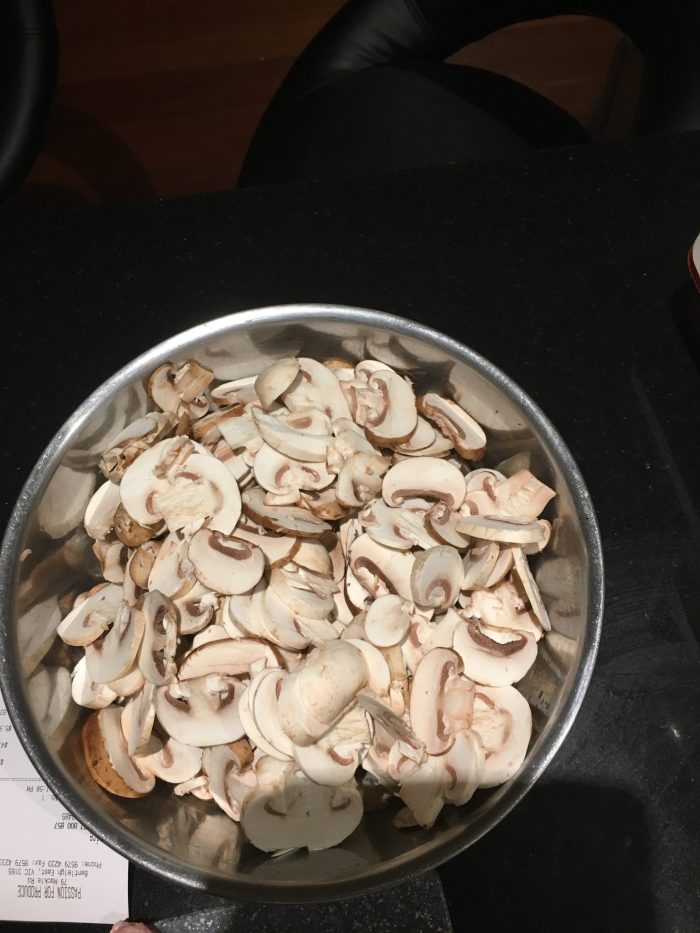I’m not sure how I fell in love with cooking. Maybe it started as an eleven year old, lifting the lid on a saucepan, leaning in to sniff the quietly bubbling sour cherry sauce my mother prepared to pour over slow cooked lamb. How melted cheese dangled off the cauliflower as she scooped up helpings. Or my father, normally a distant figure in a suit, leaving for work when it was too early for conversation and arriving home too tired to speak. On Sundays he wore a ‘kiss the cook’ apron, smoke billowing from a brick barbecue he’d built with more care than the lamb chops and slices of tinned pineapple he inflicted second degree burns on under his spatula. It could have been as a father myself, lifting my daughters onto a chair so they stood at the sink washing mushrooms before the evening meal. Then watching them ease a wooden spoon into a saucepan filled with nothing but water, concentrating while they stirred, as if it was an exotic sauce that had to be exactly right.
The first joy of cooking is flavours. There’s plenty to work with, as there can be with painting, photography or literature. Even working in those arts you’re reminded of the importance of colour, presentation, expression, texture and in particular, how it makes you and others feel. Along the way I’ve found the magic of what I can only call “intersecting flavours.” It’s in essence nothing more than adding a little of this, a tiny bit of that. A few herbs, pinch of salt, dash of mustard, half a cup of cream, pinch of ground pepper and cheeky dash of wine. All those flavours then blend and begin working together. You’re invested in that meal as soon as the aromas reach you. You sneak a taste, followed by a tweak, adding something to sweeten or make savoury. Already the colours promise how the meal will look on the plate. You might even be considering the plate’s colour. Black showcases the white ribbons of pasta. The white flesh of fish also presents well on black. But is that charcoal grilled meat lost on a black plate? White meanwhile allows the green of vegetables to be highlighted. The oranges of carrots, pumpkins or salmon look great against the plate’s white background.
Once you peel back the taste there’s the other rewards of cooking. Australian chef Josh Niland has a passion for cooking without waste. Imagine that, in our throwaway world cooking to minimise harm to our environment by not creating rubbish ending up in landfill. Sydney photographer Rob Palmer captured the respect and intimacy Niland feels as he handled a fish in an award winning photograph earlier this year.
For me there’s the satisfaction of cooking with local produce. I refuse to buy the imported cherries, plums or apricots harvested from places such as Washington or California during their summer and then exported to Australia during our winter. (As tempting as it is). I’m more likely to be found at a local farmer’s market. Potatoes from Ballarat (an hour and a half’s drive), mandarins from Mildura on the Murray River, plums from up the road at Narre Warren. Knowing these have been picked from trees or dug from ground during the past few days means the produce has detoured cool rooms and warehouses. It’s almost paddock to plate. While discussing paddock to plate, there’s the additional satisfaction of growing your own food, something many people are discovering during these self- isolation times. Snapping off corn and beans, snipping tomatoes and bringing them straight to the kitchen. Immediately your fingers smell of the goodies you’ve grown. With local produce there’s the colour and that firmness suggesting fresh to the touch. But it’s beyond that. By choosing local or growing your own, you reduce the carbon emissions otherwise used to transport produce over long distances. A small but vital contribution towards how we minimise climate change.
Another joy is the feeling of community. Community can mean different things. It may be growing and sharing produce from a community garden, rubbing shoulders with and learning from other gardeners. It can be family, gathering around a table to discuss the working day, school or whose turn to wash up. It can be slumped on couches, plate balanced in lap, eating while watching the news. Or it means friends. Gathered around barbecues, smokers, kitchen benches or on outdoor furniture. Salad bowls are passed, drinks poured, trays of food passed. It’s a ritual as old as sitting around camp fires dressed in animal skins, ripping meat from bones.
Lately food has turned into art. Chefs become celebrities. Menus are written by food designers. Making a meal a competition on television. Restaurant dishes liked (or insulted) on social media. Our food can be described as deconstructed, degustation, plated and rested rather than merely delicious.
To cook is to smell, taste, hear the sizzle, be sustainable, respect, present and above all to love.
Bon appetit.









Read 1 comment and reply